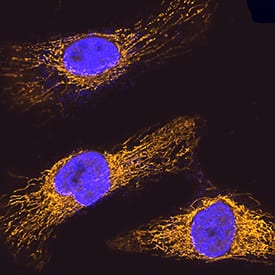Human/Mouse/Rat GRP75/HSPA9B Antibody
R&D Systems, part of Bio-Techne | Catalog # AF3584

Key Product Details
Species Reactivity
Applications
Label
Antibody Source
Product Specifications
Immunogen
Glu542-Gln679
Accession # P38646
Specificity
Clonality
Host
Isotype
Scientific Data Images for Human/Mouse/Rat GRP75/HSPA9B Antibody
Detection of Human/Mouse/Rat GRP75/HSPA9B by Western Blot.
Western blot shows lysates of HepG2 human hepatocellular carcinoma cell line, CH-1 mouse B cell lymphoma cell line, and L6 rat myoblast cell line. PVDF membrane was probed with 0.5 µg/mL of Goat Anti-Human/Mouse/Rat GRP75/HSPA9B Antigen Affinity-purified Polyclonal Antibody (Catalog # AF3584) followed by HRP-conjugated Anti-Goat IgG Secondary Antibody (Catalog # HAF109). A specific band was detected for GRP75/HSPA9B at approximately 75 kDa (as indicated). This experiment was conducted under reducing conditions and using Immunoblot Buffer Group 2.GRP75/HSPA9B in HeLa Human Cell Line.
GRP75/HSPA9B was detected in immersion fixed HeLa human cervical epithelial carcinoma cell line using Goat Anti-Human/Mouse/Rat GRP75/HSPA9B Antigen Affinity-purified Polyclonal Antibody (Catalog # AF3584) at 5 µg/mL for 3 hours at room temperature. Cells were stained using the NorthernLights™ 557-conjugated Anti-Goat IgG Secondary Antibody (yellow; Catalog # NL001) and counterstained with DAPI (blue). Specific staining was localized to mitochondria. View our protocol for Fluorescent ICC Staining of Cells on Coverslips.GRP75/HSPA9B in Human Meningioma.
GRP75/HSPA9B was detected in immersion fixed paraffin-embedded sections of human meningioma using 15 µg/mL Goat Anti-Human/Mouse/Rat GRP75/HSPA9B Antigen Affinity-purified Polyclonal Antibody (Catalog # AF3584) overnight at 4 °C. Tissue was stained with the Anti-Goat HRP-DAB Cell & Tissue Staining Kit (brown; Catalog # CTS008) and counterstained with hematoxylin (blue). Lower panel shows a lack of labeling if primary antibodies are omitted and tissue is stained only with secondary antibody followed by incubation with detection reagents. View our protocol for Chromogenic IHC Staining of Paraffin-embedded Tissue Sections.Applications for Human/Mouse/Rat GRP75/HSPA9B Antibody
Immunocytochemistry
Sample: Immersion fixed HeLa human cervical epithelial carcinoma cell line
Immunohistochemistry
Sample: Immersion fixed paraffin-embedded sections of human meningioma and colon cancer tissue
Western Blot
Sample: HepG2 human hepatocellular carcinoma cell line, CH-1 mouse B cell lymphoma cell line, and L6 rat myoblast cell line
Formulation, Preparation, and Storage
Purification
Reconstitution
Formulation
Shipping
Stability & Storage
- 12 months from date of receipt, -20 to -70 °C as supplied.
- 1 month, 2 to 8 °C under sterile conditions after reconstitution.
- 6 months, -20 to -70 °C under sterile conditions after reconstitution.
Background: GRP75/HSPA9B
The 70 kDa heat shock proteins (HSP70s) are a highly conserved family of stress response proteins. The HSP70 family of proteins contains both heat/stress inducible and constitutively expressed members known as heat shock cognate proteins. Glucose Regulated 75 kDa Protein (GRP75, also known as HSPA9B, mitochondrial HSP70, and mortalin-2) is a 679 amino acid (aa) heat shock cognate protein. Many HSPs function as molecular chaperones, facilitating the folding of other cellular proteins. GRP75 is a mitochondrial protein involved in protein translocation into the mitochondria. Proteins crossing the mitochondrial membrane require unfolding before entering translocation pores in the mitochondrial outer membrane. GRP75 together with other inner membrane proteins of the mitochondria mediate this process. GRP75 also plays a role in the control of cell cycle progression.
Long Name
Alternate Names
Gene Symbol
UniProt
Additional GRP75/HSPA9B Products
Product Documents for Human/Mouse/Rat GRP75/HSPA9B Antibody
Product Specific Notices for Human/Mouse/Rat GRP75/HSPA9B Antibody
For research use only



